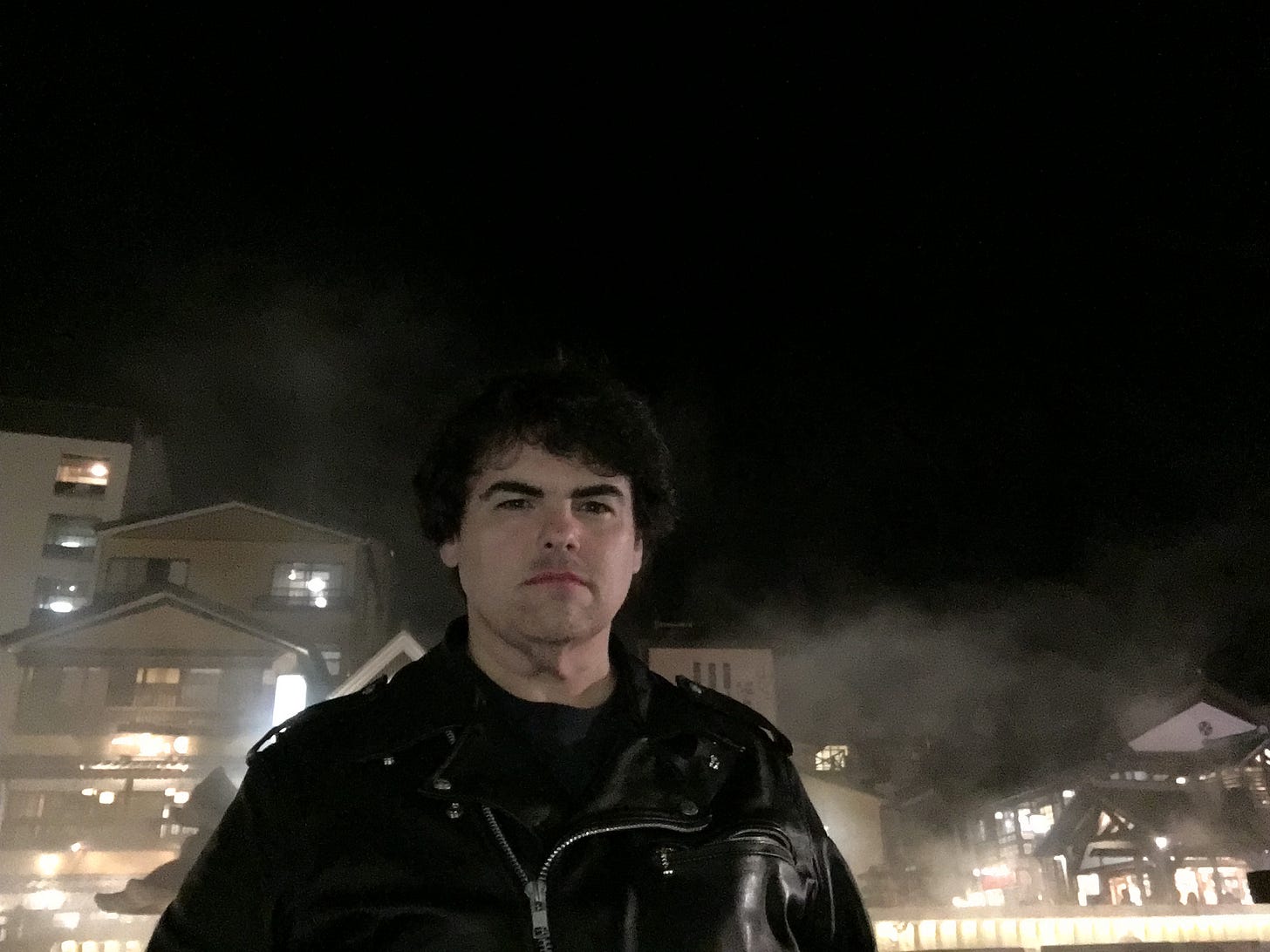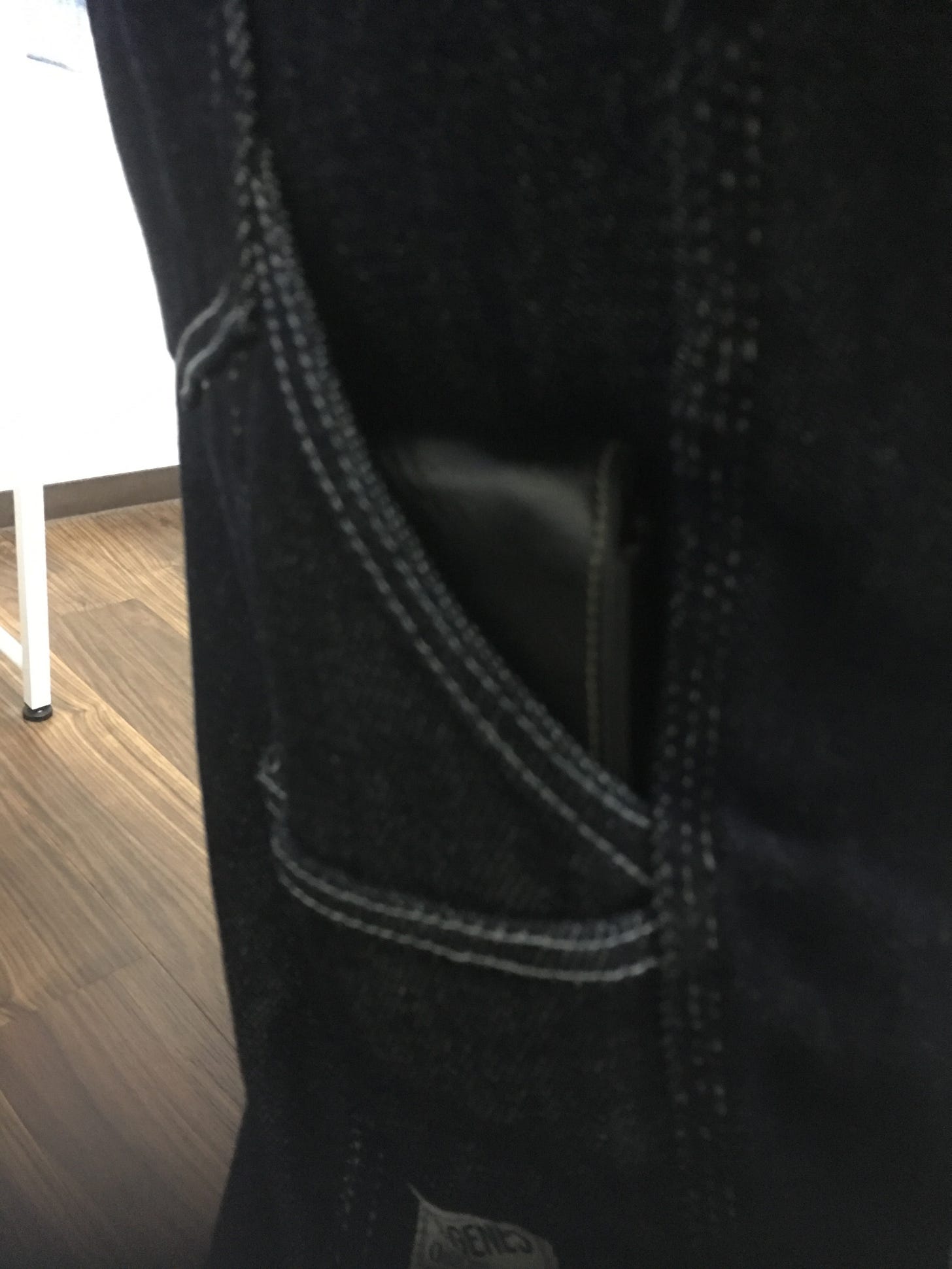Trigger warning: Discussion of trans trauma, growing up trans, mention of suicidality, archaic trans terms, casual alcohol use.
The old warrior stood stoically in front of the gates to Fushimi Inari-taisha, an unusual sight among the civilians and tourists that graced the fox kami’s presence. Sweat creased her brow as the sun blazed overhead; what had once been a proud march had degenerated to a weary shuffle. Despite this, she remained standing erect, the warrior always ready, her black armor glistening in the afternoon sunlight, her weapons in reach at her hip.
She had no understanding of the call that had led her here. Was it wisdom? Was it fate? Was it forgiveness? Perhaps a blessing from the kami? Or was it simply the chase for games and distractions that had led her to this point? She had spent most of the day searching for a game of mahjong or go or shogi to pass the time; this was simply a secondary stop on her journey. The search for games had proven fruitless; all she’d had to show for the day was some food and drink, and little more.
Unbeknownst to her, the kami had led her to this point, this place and time. They had already blessed her, already baptized her the night before. But such blessings are never without condition, never without expectation. The old warrior would have to face herself, would have to find peace in herself. And, while it would be months before she would know the truth, before another’s blade would stab her and show her the truth, the kami’s lessons would begin on that mountain.
I was wearing armor that day.
My weapons - my pen case - were in reach at my hip.
I had been searching for a game of mahjong or go or shogi.
And I was baptized by the kami even the night before - the reason I was wearing the armor in the first place.
So. Why all this? Why armor; why did I feel I needed the protection? And why the blessing?
I had been blessed the night before - baptized, in a way that a particular group of people would understand instantly. And, oddly enough, it was because of that baptism that I wore my armor that day…
I was in Tokyo the previous evening.
Any good trip to Japan requires some planning, even if - in some cases especially if - we want to go to out-of-the-way places. And there were some unconventional places I’d wanted to go to in this trip. During my five weeks there, I bathed in the waters of Kusatsu Onsen and walked through the beautiful fall countryside, bought a pair of jeans at Kojima Jeans Street in Okayama (more on that later), fed the rabbits that proliferated on Okunoshima Island, and attended a Takarazuka Revue show.
On October 20th and 21st, I had plans. October 20th, I would go to the United Nations University in the Shibuya district of Tokyo, then see the nearby sights. I went to the farmer’s market in front of the university, enjoyed cola made from genuine kola nuts, then walked to Harajuku to experience the insanity of Takeshita Street. Once I (very quickly) got my fill of Takeshita Street, the otaku in me was insistent on visiting one of the more conventional, boring areas of Tokyo: Nerima.
And, once I stepped out of the subway terminal, it began to rain - hard.
I remember the rain had seemingly come out of nowhere. I also remember it being uncomfortably cold, shiveringly cold; it was a hard rain, relentless, one that soaked to the bone. I took shelter underneath awnings for awhile as I tried to walk through the district, and eventually gave up and ducked into a bakery. I bought a loaf of warm foccacia bread for respite from the storm, and tore off pieces of the loaf as I watched the rain pour down.
But the blessing was done. The Kami had, in their own way, baptized me, and given a hint as to what the future held.
Now, as for why some random rainstorm would be a blessing…
When I was in college, I became a fan of an anime series called Ranma 1/2. Ranma 1/2 as an anime was fairly light comedy. The story was about a male martial artist with an unusual curse: when splashed with cold water, he would change into a woman. (Hot water would change him back.)

Needless to say, Ranma 1/2 attracted trans women like moths to a flame. Once I started watching, I was hooked. And, for reasons that should (and likely will) form an essay of their own, writing Ranma 1/2 fanfiction helped prepare my psyche for when my own egg cracked, when I figured out I was trans, in February 1997.
And where, you might ask, was the Ranma 1/2 series based? Nerima, of course. Many a Nerima rainstorm figured in the events of the series, whenever an unexpected gender change was needed. And the kami had just seen fit to give me a Nerima rainstorm of my own. Needless to say, as it rained down, I was wishing the water would have the same effect on me as it did on Ranma.
Perhaps it did, in its own way. By the point of the trip to Japan, I was holding onto what facade of manhood I had by my fingernails. Much of that 2018 year was slowly processing the possibility of transitioning - and much of the trip climbing up Fushimi Inari-taisha would be pondering that transition. For so long, I had viewed transitioning as an impossible task - but, more and more, I was starting to think of it as a necessary one.
This was why the trip up Fushimi Inari-taisha was so important. Here was this impossible wish - but was it possible? That would form many of my concerns on the trip up the mountain.
Now. What did I wear on this trip up Fushimi Inari? FUCKING ARMOR.
No joke. Armor.
All too often, to be a trans person is to carry trauma. No, not simply from being trans, but from being in a world that sometimes does not understand, and sometimes does not accept, a person being trans.
Imagine you are told, from a very early age, that you must be a certain way that does not conform to who you are. Boys do boy things, girls do girl things, and Kami help you if you’re a boy caught doing girl things.
Like crying. I remember being such a crybaby when I was a child. Now, even with the changes in hormones, it is still very difficult for me to cry, because of the conditioning from then.
The gender divide intensifies as we go from grade school into middle school / junior high. As novelist April Daniels put it in her book Dreadnought, “The dirty little secret about growing up as a boy is if you’re not any good at it, they will torture you daily until you have the good graces to kill yourself.” And yes - the bullying from classmates at that age felt particularly vicious for me. While I never attempted suicide, I certainly thought about it - and this late grade-school age was when those thoughts began.
I was a geek. I devoured books, anything that got my attention. I loved solving problems; I would solve logic problems in the back of my parents’ car while being driven around. When it came to sports, I was competitive and loved to play, but not at the cost of having fun; if I wasn’t enjoying it, there wasn’t much point. So, in that time of life when everyone was growing up and no one understood what that really meant, when I was very far from this nebulous picture that other boys had of being male, I was bullied a lot, and further isolated from others.
With each year, with each day, the gender divide gets wider and wider. Some of us figure out we’re trans by then, some of us don’t. Society isn’t exactly equipped to help us figure it out, and in some cases is hostile to us doing so; for the most part, until very recently we had to figure it out on our own. I remember looking up what scant information I could find on trans issues in the library in high school - but I was still cis, I swear! (The language was very different then, far more cringeworthy; the words generally used were “transsexual” and “transvestite” and “cross-dressing”. And if I knew even of the existence of Search Histories then, I would have died of embarrassment!)
And the trauma builds. We’re forced to live a life that doesn’t fit us in so many ways. Maybe we make it to adulthood, and have to play the role we’re expected to play; put on the suit and tie, be the man, be the breadwinner. Each day brings more trauma.
For those that are trans, to live in a gender outside of how we see ourselves is not living. It is surviving - and barely, at that.
How the trauma from that deadlife manifests itself varies from trans person to trans person. Some trans people pre-transition hate looking at themselves in a mirror. Some absolutely refuse to take selfies; during my trip to Japan, I took… two selfies? Maybe? (And that was because the place looked so cool that I thought it’d make the perfect place for an 80s style music video!)
But for so many of us, our traumas are shielded by what we wear. Some of us wear baggy clothes, sweatshirts and hoodies and oversized t-shirts, to hide the shape of our bodies. And some of us, quite literally, wear armor.

A few months ago, I went to a meeting of trans women at a local donut shop. It was winter, so cold-weather clothing would be expected. What struck me about the meeting, though, was just how many genuine, high-quality leather motorcycle jackets there were in the group.
A genuine motorcycle jacket designed to protect the rider, as opposed to a leather jacket that just looks good, is almost immediately recognizable. It is thick, and stiff; the leather flexes in a way that communicates its strength, that almost protests such an intrusion on its existence. It is heavy; if someone tries to pick it up, they will complain about the weight. (I think I weighed my jacket, with inner lining to protect from the cold, at about 12 pounds, once?)
It is, in a word, armor. And it was very strange to see so many in a group that wasn’t a motorcycling group. In a group of trans women, in a group that had experienced some significant trauma by not meeting what was expected of them by society, the amount of armor in that room was telling.
My armor that day at Fushimi Inari didn’t stop at my jacket. I was on a denim kick as well - and Japan makes some of the most insane denim on the planet. Early in my trip, I’d gone to Kojima Jeans Street, to a company called Kojima Genes, and picked up a pair of painter’s pants.
The denim on these painter’s pants, just as the leather on the jacket, was thick - roughly twice the thickness of ordinary denim. Typical Levi’s denim is about 12.5 oz. (i.e. 12.5 oz of cotton to make a yard of fabric); these were 22 oz. I’ve owned and worn denim as thick as 33 oz., which is about as thick as you can possibly find. Wearing jeans like this is almost like wearing industrial carpet on your legs.
Like I said: Armor.
So imagine someone walking through Kyoto on a sunny day wearing this armor. I had dressed based on the rain I had experienced in Nerima the previous day, but it wasn’t quite appropriate for the current weather conditions. It was a hot, sunny day; temperature readings for the day showed 72℉, but it felt a lot warmer. The locals must have thought I was insane - or, at the very least, some foolish foreigner. (They would have been right on the latter.)
Now, to be fair, Fushimi Inari was not my primary reason for going to Kyoto that day. On the 21st of every month, Toji Temple, also in Kyoto, holds a flea market. I had hoped to shop around, see what was there; my primary goal there was to find a game set - specifically, a mahjong set, go set, or shogi set that I could take back with me. Unfortunately, I had no such luck. The street food there was quite good, though, and I geeked out on the woodworking available.
The heat and the armor, though, were getting to me. After Toji, I needed a bit of a break. I bought two Coke Zeros, guzzled one, then found an Irish pub intended to cater to tourists. Sometimes the most blessed words one can say is “Guinness, kudasai.” The beer tasted heavenly as I drank; I idled my time by looking at the currency that visiting tourists had stapled to the walls and ceiling, getting rehydrated, getting my strength and my wits back.

So I was tired, a bit inebriated, but rehydrated by the time I made it to Fushimi Inari-taisha. I went to the cleansing area to purify, approached the gate, and began my journey.
That said, I had little clue for what was in store.
(Continued in Part 2)
Author’s note: Not sure how often these will be. Want to try for once every two weeks or so.




